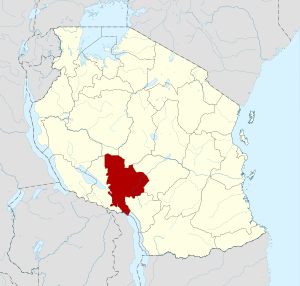Mbeya Region
Mbeya Region
Mkoa wa Mbeya (Swahili) | |
|---|---|
 Tea fields in Tukuyu | |
 Location in Tanzania | |
| Country | Tanzania |
| Zone | Southern Highlands |
| Capital | Mbeya |
| Government | |
| • Regional Commissioner | Albert Chalamila |
| Area | |
| • Total | 35,954 km2 (13,882 sq mi) |
| • Land | 35,493 km2 (13,704 sq mi) |
| • Water | 461 km2 (178 sq mi) |
| Population (2012) | |
| • Total | 2,707,410 |
| • Density | 75/km2 (200/sq mi) |
| Time zone | UTC+3 (EAT) |
| Postcode | 53xxx |
| Area code(s) | 025 |
| HDI (2018) | 0.523[2] low · 14th of 25 |
| Website | Regional website |
Mbeya Region is one of Tanzania's 31 administrative regions. It is located in the country's southwest. The regional capital is the city of Mbeya. According to the 2012 national census, the region had a population of 2,707,410, which was lower than the pre-census projection of 2,822,396.[3]:page 2 For 2002-2012, the region's 2.7 percent average annual population growth rate was tied for the tenth highest in the country.[3]:page 4 It was also tied for the eighteenth most densely populated region with 45 people per square kilometre.[3]:page 6 In 2016, the town of Tunduma and the districts of Ileje, Mbozi, Momba and Songwe (created from the western part of Chunya District[4]) were split from Mbeya Region to create Songwe Region.[5][6] Mbeya Region is now bordered to the northwest by Tabora Region, to the northeast by Singida Region, to the east by Iringa Region, to the south by Songwe Region and Malawi, and to the west by Songwe Region.[7] Prior to the creation of Songwe Region, Mbeya Region covered an area of 62,420 square kilometres (24,100 sq mi).[8] It now covers an area of 35,954 square kilometres (13,882 sq mi).[1]
Districts[]
2012[]
In 2012, the region was administratively divided into eight districts:
| Districts of Mbeya Region in 2012 | |||||||
|---|---|---|---|---|---|---|---|
| Map | District | Population (2012 Census) | |||||

|
Chunya District | 290,478 | |||||
| Ileje District | 124,451 | ||||||
| Kyela District | 221,490 | ||||||
| Mbarali District | 300,517 | ||||||
| Mbeya District | 690,598 | ||||||
| Mbozi District | 446,339 | ||||||
| Momba District | 294,380 | ||||||
| Rungwe District | 339,157 | ||||||
| Total | 2,707,410 | ||||||
2016[]
After the 2016 reorganization, Mbeya now comprises seven districts:[7]
| Districts of Mbeya Region in 2016 | |||||||
|---|---|---|---|---|---|---|---|
| Map | District | Population (2012 Census) | |||||

|
Busokelo District | n/a | |||||
| Chunya District | 156,786 | ||||||
| Kyela District | 221,490 | ||||||
| Mbarali District | 300,517 | ||||||
| Mbeya District | 305,319 | ||||||
| Mbeya City | 385,279 | ||||||
| Rungwe District | 339,157 | ||||||
| Total | 1,708,638 | ||||||
National Parks and other sites.[]
- Ruaha National Park
- Kitulo National Park
- Mount Rungwe Forest Reserve
- Lake Ngosi (Crater lake)
- Matema Beach
Transport[]
Mbeya region is accessible by Roads, rail, air and water through Lake Nyasa.
Airports[]
Mbeya region is served by Songwe International Airport which is located in Mbeya district at Songwe area. Currently the only carrier which have scheduled flights is Air Tanzania with daily flights to Dar es salaam. There are also other chartered flights to other places such as Ruaha National Park.
Roads[]
TANZAM Highway (T1) which is part of the Great North road (A 104) pass through the region, it connect the region with Njombe region to the East and Songwe region to the West. The B - 345 road connect the region with Malawi to the south from Uyole.Chunya road connect the region with Singida and Tabora to the North-East and North-West respectively.
Water[]
Mbeya region is bordered by Lake Nyasa to the South East. The lake is used for transport by Mbeya region and the neighboring regions of Njombe, Ruvuma and the country of Malawi. Three ships of which two are cargo ships MV Njombe and MV Ruvuma and one for passengers MV Mbeya II are on final stages of construction and are expected to start operations at the end of 2019.
Railway[]
The TAZARA rail pass through the region and connects which connects it to the Port city of Dar es salaam and Zambia.
Geology[]
It was announced in February 2012 that the collapsed volcano approximately 200 km north of Mbeya, Mount Ngualla, contained one of the largest rare earth oxide deposits in the world.[9]
Writers from Mbeya Region[]
References[]
| Wikimedia Commons has media related to Mbeya Region |
- ^ Jump up to: a b "Mbeya Regional Profile" (PDF). Mbeya Regional Commissioner's Office. 2016. Retrieved 1 December 2017.
- ^ "Sub-national HDI - Area Database - Global Data Lab". hdi.globaldatalab.org. Retrieved 26 February 2020.
- ^ Jump up to: a b c Population Distribution by Administrative Units, United Republic of Tanzania, 2013 Archived 2 May 2013 at the Wayback Machine
- ^ "History". Songwe District Council. Retrieved 1 December 2017.
- ^ "History". Songwe Regional Commissioner's Office. Retrieved 1 December 2017.
- ^ Mwakyusa, Alvar (4 February 2016). "Songwe is new region - with four districts". Daily News. Archived from the original on 5 February 2016. Retrieved 21 February 2017.
- ^ Jump up to: a b "Welcome to Mbeya Region". Mbeya Regional Commissioner Office. Archived from the original on 22 February 2017. Retrieved 21 February 2017.
- ^ Statistical Abstract 2011, Tanzania National Bureau of Statistics Archived 5 November 2013 at the Wayback Machine
- ^ Peak Resources - Maiden Resource, Ngualla Rare Earth Project, ASX Announcement, 29 February 2012
- Mbeya Region
- Regions of Tanzania
